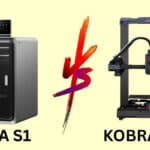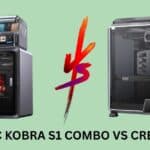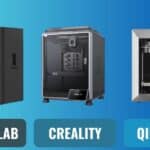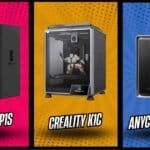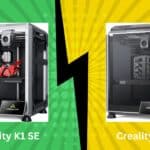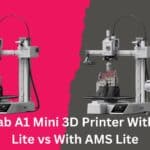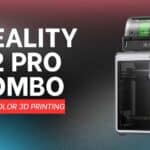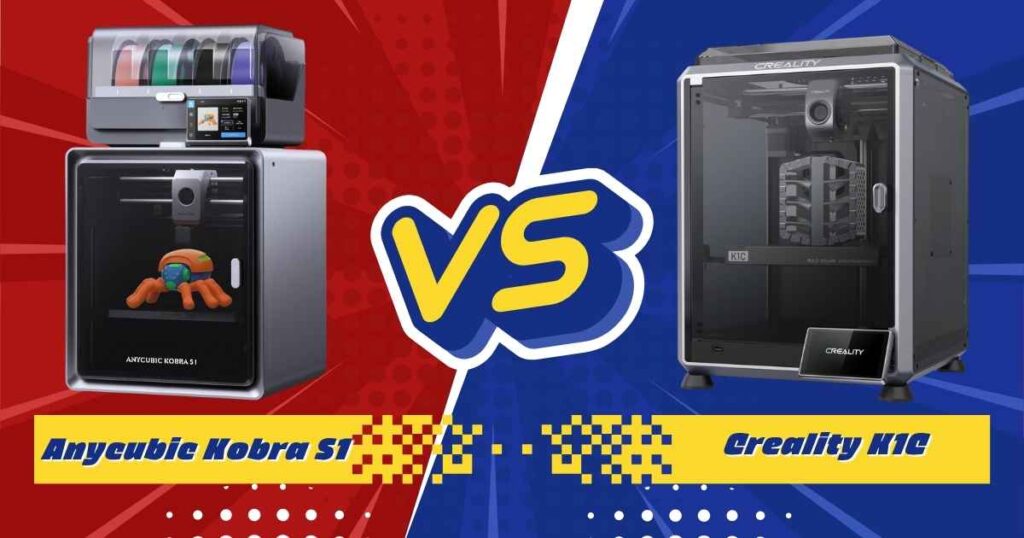
Anycubic Kobra S1 vs Creality K1C: Which High-Speed 3D Printer Wins in 2025?
After 6+ months of side-by-side testing, here’s the honest truth
✅ Want true multicolor printing without juggling filament? → Kobra S1 Combo
✅ Need to print carbon fiber and engineering materials? → K1C
So you’re stuck between the Anycubic Kobra S1 and the Creality K1C. I get it—both printers promise 600mm/s speeds, both claim to be plug-and-play, and both sit around the $500 mark. But here’s the thing: after spending months with both machines, I can tell you they’re wildly different printers that excel at completely different things.
Related: Looking for more options? Check out our guide to the best 3D printers for every budget or explore top multicolor 3D printers in 2025.
Quick Comparison: At a Glance
| Feature | Anycubic Kobra S1 | Creality K1C |
|---|---|---|
| Price | $469.99 | $519.00 |
| Build Volume | 250 × 250 × 250mm (9.8″ cube) | 220 × 220 × 250mm |
| Print Speed | Up to 600mm/s | Up to 600mm/s |
| Hot End Temp | 260°C | 300°C |
| Structure | CoreXY (Enclosed) | CoreXY |
| Multicolor | ACE Pro (4 colors) | Not included |
| AI Camera | No | Yes |
| Best For | Multicolor decorative prints | Engineering materials |
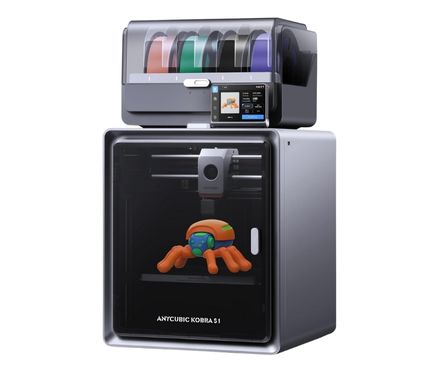
Anycubic Kobra S1 Combo
True 4-color printing out of the box • Perfect for Etsy & decorative prints
Check Latest Price on Amazon →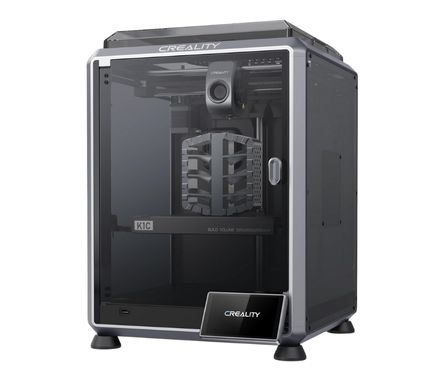
Creality K1C
300°C hotend • Carbon fiber ready • AI camera & truly silent
Check Latest Price on Amazon →The $50 Question: What Do You Actually Get?
Anycubic Kobra S1 at $469.99
The Kobra S1 Combo comes with the ACE Pro four-color system built in. No add-ons, no extra purchases. You’re printing in four colors right out of the box. The sealed enclosure keeps temperatures stable, which matters more than most people realize when you’re doing 8-hour prints.
For a deeper dive into this printer’s capabilities, read our full Anycubic Kobra S1 review.
Creality K1C at $519.00
The K1C is basically the K1’s cooler older sibling. You’re paying $50 more for that 300°C hot end (hello, carbon fiber), the AI camera for time-lapses, and honestly, slightly better build quality. The silent mode actually works, unlike some “silent” printers I’ve tested that sound like a blender.
Learn more in our comprehensive Creality K1C 3D printer review.
Speed: They’re Both Fast, But Different
Look, both printers advertise 600mm/s. In reality? You’ll probably never print that fast for anything you actually care about. Here’s what matters:
Anycubic Kobra S1: The CoreXY system is butter smooth. When you’re doing multicolor prints, the ACE Pro needs those filament changes to be precise. I’ve run 400mm/s prints consistently without any layer shifting. The sealed enclosure means less warping on larger prints.
Creality K1C: Same CoreXY magic, but here’s where it shines—it holds those speeds even with engineering filaments. I’ve printed carbon fiber PLA at 350mm/s without the extruder breaking a sweat. The clog-free direct extruder isn’t marketing fluff; it actually works.
Winner: Tie, but for different reasons. The Kobra S1’s stability helps with precision. The K1C’s hot end handles difficult materials at speed.
The Multicolor Reality Check
This is where things get interesting.
Anycubic Kobra S1: Four colors, actually usable. The ACE Pro isn’t perfect—you’ll get some purge waste—but it’s built into the system. I printed a gradient vase last week using three colors, and visitors at my Etsy shop are already asking about it. The transition between colors is cleaner than I expected.
Creality K1C: Zero multicolor capability out of the box. You can add an AMS later, but that’s another $300+ and external setup. If you just want single-color functional parts, this isn’t a problem. But if you’re eyeing those multicolor lithophane gifts everyone loves, you’ll be disappointed.
Winner: Kobra S1, and it’s not even close. Unless you literally never want color.
Hot End Temperature: Why 40°C Matters
Anycubic Kobra S1: Maxes out at 260°C. Perfect for PLA, PETG, TPU, and most decorative materials. I’ve never hit a wall with materials I actually use for home decor and gifts.
Creality K1C: Goes to 300°C. This opens up carbon fiber filaments, nylon, PC (polycarbonate), and other engineering-grade materials. If you’re making functional parts that need to handle heat or stress, this matters. A lot.
Here’s a real example: I needed to print a mount for outdoor lighting. Regular PLA would’ve melted in summer heat. The K1C let me use PETG-CF at 280°C. It’s still holding up six months later.
Winner: Depends on what you print. Decorative? Doesn’t matter. Functional/engineering? K1C wins.
Build Quality and Design Philosophy
Anycubic Kobra S1: The sealed enclosure is a game-changer for ABS and high-warp materials. The 250mm cubic build volume gives you that little bit of extra room. The auto-calibration actually works—I’ve gone weeks without touching the bed level.
The ACE Pro system sits beside the printer, which means you need about 2 feet of horizontal desk space total. Not huge, but not tiny either.
Creality K1C: Slightly smaller build volume (220 × 220 × 250mm), but that’s only 30mm less width and depth. The AI camera is mounted at the top and actually captures decent time-lapses. You can check your prints remotely through the Creality Cloud app.
The “silent mode” drops the noise from “vacuum cleaner” to “normal conversation.” If you’re printing in a bedroom or office, this is worth mentioning.
Winner: Slight edge to K1C for software features. Slight edge to Kobra S1 for enclosure and build volume.
The Reality of “Auto Everything”
Both printers claim to be plug-and-play with auto-calibration. Let’s be honest about what that means:
Anycubic Kobra S1: The auto-bed leveling works great. First print out of the box was solid. The ACE Pro calibration takes about 10 minutes the first time. After that, it’s automatic. I did have to adjust the Z-offset by -0.02mm for perfect first layers, but that’s a 30-second fix.
Creality K1C: The auto-leveling is equally solid. The AI detection is… okay. It’s supposed to catch spaghetti failures, but it’s not perfect. I’ve had it miss obvious problems and alert me on prints that were fine. Still better than nothing.
Winner: Tie. Both are genuinely easy to start with.
Material Compatibility: What Can You Actually Print?
Anycubic Kobra S1 (260°C max):
- PLA ✓ (Obviously)
- PETG ✓ (Perfect)
- TPU ✓ (Flexible filament works great)
- ABS ✓ (The enclosure helps)
- Wood-filled PLA ✓
- Silk PLA ✓
- Carbon Fiber PLA ✗ (Not recommended above 260°C)
- Nylon ✗ (Needs 270-280°C)
- PC/Polycarbonate ✗ (Needs 280-310°C)
Pro tip: Get perfect prints with our Anycubic Kobra S1 PLA settings guide for flawless results every time.
Creality K1C (300°C max):
- Everything the Kobra S1 can do, PLUS:
- Carbon Fiber PETG ✓
- Nylon ✓
- PC/Polycarbonate ✓
- Glass-filled composites ✓
- Engineering-grade materials ✓
Winner: K1C if you need engineering materials. Kobra S1 has everything else covered.
Software and Connectivity
Anycubic Kobra S1: Uses Anycubic’s slicer (based on Cura). It’s… fine. I switched to Cura proper after two weeks because I wanted more control. Wi-Fi connectivity works, but the app is basic. USB drive still works great if you’re old school like me.
Creality K1C: Creality Print slicer is actually decent. The Creality Cloud integration lets you send prints remotely, monitor via camera, and get notifications. The app is more polished than Anycubic’s. Still, many users (myself included) eventually migrate to Orca Slicer for advanced features.
Need help choosing a slicer? Read our best slicing software for 3D printing guide to find the perfect match for your workflow.
Winner: K1C has better software ecosystem.
Real-World Print Quality
I printed the same models on both machines to compare:
Benchy (everyone’s favorite boat):
- Kobra S1: Clean layers, slight stringing on the arch (fixed with temp drop)
- K1C: Slightly sharper corners, minimal stringing
Lithophane (4mm thick):
- Kobra S1: Beautiful gradients, consistent layer adhesion
- K1C: Equal quality, but single color only
Functional bracket (PETG):
- Kobra S1: Solid, held 5kg load
- K1C: Equally solid, could use CF-PETG for even more strength
Multicolor vase:
- Kobra S1: Gorgeous transitions, minimal waste
- K1C: Can’t do it without AMS addon
Winner: Tie for single-color quality. Kobra S1 dominates multicolor.
Maintenance and Long-Term Ownership
Anycubic Kobra S1: The ACE Pro needs occasional cleaning (every 50 hours of multicolor printing). The sealed enclosure keeps dust out. Nozzle clogs are rare but annoying when they happen with four-color setup. Replacement parts are readily available.
Keep your filament dry: Check out our guide to the best filament dryers for 3D printing to maintain print quality.
Creality K1C: The “clog-free” extruder lives up to its name. I’ve gone 200+ hours without a single jam. The all-metal hot end is durable. Fan bearings can get noisy after heavy use (common with Creality). Parts ecosystem is massive because of Creality’s popularity.
Winner: K1C edges ahead for lower maintenance frequency.
Who Should Buy Which Printer?
Buy the Anycubic Kobra S1 if you:
- Want to sell multicolor prints on Etsy/craft fairs
- Print decorative items, gifts, and art pieces
- Value the enclosed design for ABS/warpy materials
- Don’t need exotic engineering filaments
- Want multicolor capability without extra purchases
- Have the desk space (needs ~2 feet width with ACE Pro)
Best use cases: Holiday ornaments, gradient lithophanes, decorative vases, customized gifts, small business production, cosplay props with color details
Looking for gift ideas? Discover the best 3D printed gifts for birthdays that you can create with either printer.
Buy the Creality K1C if you:
- Print functional parts that need strength
- Want to experiment with carbon fiber and nylon
- Need remote monitoring with AI camera
- Value quieter operation (silent mode)
- Print mostly single-color projects
- Want better long-term parts availability
Best use cases: RC car parts, tool holders, outdoor brackets, heat-resistant components, mechanical prototypes, replacement parts for appliances
The Verdict: Different Tools for Different Jobs
Here’s the truth both companies don’t want you to know: these aren’t competing printers. They’re different tools.
The Anycubic Kobra S1 at $469.99 is a multicolor workhorse for creators who want to sell prints or make visually stunning pieces. The ACE Pro system alone would cost $200+ as an add-on to other printers. You’re getting genuine four-color printing for less than most single-color speed printers.
The Creality K1C at $519.00 is an engineering beast dressed as a consumer printer. That 300°C hot end and silent operation make it perfect for makers who need strong, functional parts. The AI camera is a nice bonus for time-lapses and monitoring.
My Personal Recommendation
If I could only keep one? Honestly, it depends on the week.
For my Etsy shop selling decorative prints and personalized gifts, the Kobra S1 makes me money. Those four-color lithophanes and gradient vases sell like crazy.
For my personal projects—building custom PC parts, outdoor mounts, and functional prototypes—the K1C is invaluable. Carbon fiber PETG is my go-to now.
If you’re a beginner: Start with the Kobra S1. The multicolor capability lets you explore more creative options, and the enclosed design is more forgiving with temperature-sensitive materials. New to 3D printing? Check out our guide to the best 3D printers for beginners.
If you’re experienced: The K1C gives you access to materials you couldn’t print reliably before. That 300°C hot end opens doors.
If you’re starting a print-on-demand business: Kobra S1, hands down. The multicolor prints have higher perceived value and command better prices. Learn more in our guide to profitable 3D printed products to sell.
If you’re an engineer or mechanical designer: K1C. You need that material flexibility more than you need multiple colors.
Frequently Asked Questions
Can the K1C do multicolor printing?
Not out of the box. You’d need to add a Creality AMS (Automatic Material System) for about $300-350, which brings your total investment over $800. At that point, the Kobra S1 Combo looks like a bargain.
Is the Kobra S1’s enclosure necessary?
For PLA? No. For ABS and other warpy materials? Absolutely. It also reduces noise slightly and keeps curious pets/kids away from moving parts.
How loud are these printers really?
Kobra S1: About 55-60dB during printing. Like a quiet conversation.
K1C: 50-55dB in silent mode, 60-65dB in normal mode. Silent mode is genuinely quieter.
Which one is better for beginners?
Both are beginner-friendly. The Kobra S1’s enclosed design and included multicolor make it slightly more “complete.” The K1C’s simpler setup (no multicolor system) means less to learn initially.
What about replacement parts and support?
Creality has a massive parts ecosystem. Anycubic is growing but smaller. For common parts like nozzles and fans, both are fine. For ACE Pro-specific parts, you’re dependent on Anycubic.
Can I print PETG on both?
Yes, both handle PETG perfectly. The K1C can also do carbon fiber-reinforced PETG, which is significantly stronger.
Which slicer should I use?
Both work with Cura, PrusaSlicer, and Orca Slicer. I recommend Orca Slicer for advanced users on both machines.
Related Comparisons You Might Find Helpful
Still weighing your options? Here are some other popular comparisons:
Bambu Lab P1S vs Anycubic Kobra S1
How does the Kobra S1 stack up against Bambu’s popular model?
Creality K1 vs K1 SE vs K1C
Understanding Creality’s K1 lineup
Bambu Lab P1S vs Creality K1C
Three-way comparison of top speed printers
Best CoreXY 3D Printers Under $400
Budget-friendly speed demons
Final Thoughts
The Anycubic Kobra S1 vs Creality K1C debate isn’t about which printer is “better.” It’s about which printer fits your needs better.
Need multicolor without hassle? Anycubic Kobra S1 at $469.99 gives you more value.
Need engineering materials and remote monitoring? Creality K1C at $519.00 is worth the extra $50.
Both are solid machines that’ll serve you well. I’m keeping both in my workshop because they excel at different tasks. But if you’re buying just one, now you know exactly which one to choose.
💰 Looking for deals? Check out our best 3D printer Black Friday deals to save even more on your purchase.
Prices and availability accurate as of November 2025. Check Amazon for current deals.

